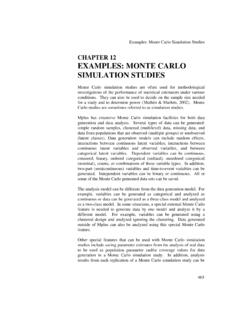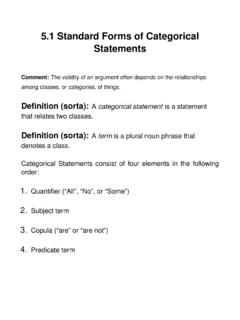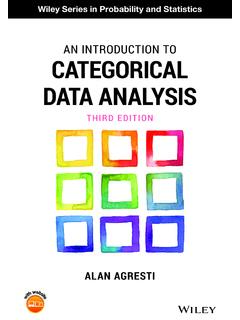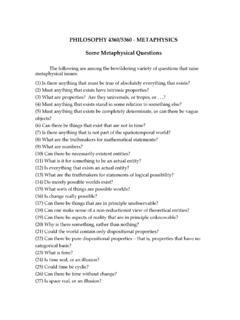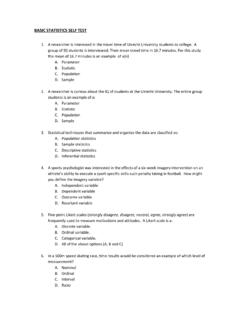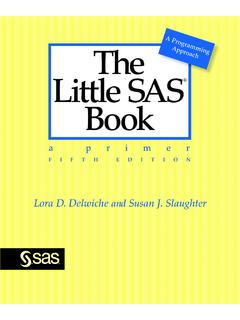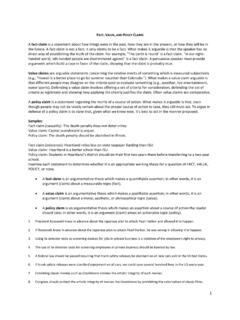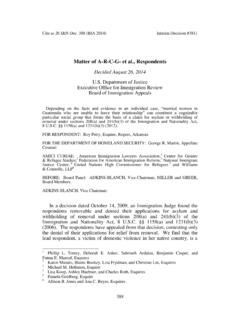Transcription of CHAPTER 5 EXAMPLES: CONFIRMATORY FACTOR …
1 Examples: CONFIRMATORY FACTOR Analysis And Structural Equation Modeling 55 CHAPTER 5 EXAMPLES: CONFIRMATORY FACTOR ANALYSIS AND STRUCTURAL EQUATION MODELING CONFIRMATORY FACTOR analysis (CFA) is used to study the relationships between a set of observed variables and a set of continuous latent variables. When the observed variables are categorical , CFA is also referred to as item response theory (IRT) analysis (Fox, 2010; van der Linden, 2016). CFA with covariates (MIMIC) includes models where the relationship between factors and a set of covariates are studied to understand measurement invariance and population heterogeneity. These models can include direct effects, that is, the regression of a FACTOR indicator on a covariate in order to study measurement non-invariance.
2 Structural equation modeling (SEM) includes models in which regressions among the continuous latent variables are estimated (Bollen, 1989; Browne & Arminger, 1995; Joreskog & Sorbom, 1979). In all of these models, the latent variables are continuous. Observed dependent variable variables can be continuous, censored, binary, ordered categorical (ordinal), unordered categorical (nominal), counts, or combinations of these variable types. CFA is a measurement model. SEM has two parts: a measurement model and a structural model. The measurement model for both CFA and SEM is a multivariate regression model that describes the relationships between a set of observed dependent variables and a set of continuous latent variables. The observed dependent variables are referred to as FACTOR indicators and the continuous latent variables are referred to as factors .
3 The relationships are described by a set of linear regression equations for continuous FACTOR indicators, a set of censored normal or censored-inflated normal regression equations for censored FACTOR indicators, a set of probit or logistic regression equations for binary or ordered categorical FACTOR indicators, a set of multinomial logistic regression equations for unordered categorical FACTOR indicators, CHAPTER 5 56 and a set of Poisson or zero-inflated Poisson regression equations for count FACTOR indicators. The structural model describes three types of relationships in one set of multivariate regression equations: the relationships among factors , the relationships among observed variables, and the relationships between factors and observed variables that are not FACTOR indicators. These relationships are described by a set of linear regression equations for the factors that are dependent variables and for continuous observed dependent variables, a set of censored normal or censored-inflated normal regression equations for censored observed dependent variables, a set of probit or logistic regression equations for binary or ordered categorical observed dependent variables, a set of multinomial logistic regression equations for unordered categorical observed dependent variables, and a set of Poisson or zero-inflated Poisson regression equations for count observed dependent variables.
4 For logistic regression, ordered categorical variables are modeled using the proportional odds specification. Both maximum likelihood and weighted least squares estimators are available. All CFA, MIMIC and SEM models can be estimated using the following special features: Single or multiple group analysis Missing data Complex survey data Latent variable interactions and non-linear FACTOR analysis using maximum likelihood Random slopes Linear and non-linear parameter constraints Indirect effects including specific paths Maximum likelihood estimation for all outcome types Bootstrap standard errors and confidence intervals Wald chi-square test of parameter equalities For continuous, censored with weighted least squares estimation, binary, and ordered categorical (ordinal) outcomes, multiple group analysis is specified by using the GROUPING option of the VARIABLE command for individual data or the NGROUPS option of the DATA command for summary data.
5 For censored with maximum likelihood estimation, unordered categorical (nominal), and count outcomes, multiple group Examples: CONFIRMATORY FACTOR Analysis And Structural Equation Modeling 57 analysis is specified using the KNOWNCLASS option of the VARIABLE command in conjunction with the TYPE=MIXTURE option of the ANALYSIS command. The default is to estimate the model under missing data theory using all available data. The LISTWISE option of the DATA command can be used to delete all observations from the analysis that have missing values on one or more of the analysis variables. Corrections to the standard errors and chi-square test of model fit that take into account stratification, non-independence of observations, and unequal probability of selection are obtained by using the TYPE=COMPLEX option of the ANALYSIS command in conjunction with the STRATIFICATION, CLUSTER, and WEIGHT options of the VARIABLE command.
6 The SUBPOPULATION option is used to select observations for an analysis when a subpopulation (domain) is analyzed. Latent variable interactions are specified by using the | symbol of the MODEL command in conjunction with the XWITH option of the MODEL command. Random slopes are specified by using the | symbol of the MODEL command in conjunction with the ON option of the MODEL command. Linear and non-linear parameter constraints are specified by using the MODEL CONSTRAINT command. Indirect effects are specified by using the MODEL INDIRECT command. Maximum likelihood estimation is specified by using the ESTIMATOR option of the ANALYSIS command. Bootstrap standard errors are obtained by using the BOOTSTRAP option of the ANALYSIS command. Bootstrap confidence intervals are obtained by using the BOOTSTRAP option of the ANALYSIS command in conjunction with the CINTERVAL option of the OUTPUT command.
7 The MODEL TEST command is used to test linear restrictions on the parameters in the MODEL and MODEL CONSTRAINT commands using the Wald chi-square test. Graphical displays of observed data and analysis results can be obtained using the PLOT command in conjunction with a post-processing graphics module. The PLOT command provides histograms, scatterplots, plots of individual observed and estimated values, plots of sample and estimated means and proportions/probabilities, and plots of item characteristic curves and information curves. These are available for the total sample, by group, by class, and adjusted for covariates. The PLOT command includes a display showing a set of descriptive statistics for each variable. The graphical displays can be edited and exported as a DIB, EMF, or JPEG file. In addition, the data for each graphical display can be saved in an external file for use by another graphics program.
8 CHAPTER 5 58 Following is the set of CFA examples included in this CHAPTER : : CFA with continuous FACTOR indicators : CFA with categorical FACTOR indicators : CFA with continuous and categorical FACTOR indicators : CFA with censored and count FACTOR indicators* : Item response theory (IRT) models* : Second-order FACTOR analysis : Non-linear CFA* : CFA with covariates (MIMIC) with continuous FACTOR indicators : Mean structure CFA for continuous FACTOR indicators : Threshold structure CFA for categorical FACTOR indicators Following is the set of SEM examples included in this CHAPTER : : SEM with continuous FACTOR indicators : SEM with continuous FACTOR indicators and an indirect effect for factors : SEM with continuous FACTOR indicators and an interaction between two factors * Following is the set of multiple group examples included in this CHAPTER : : Multiple group CFA with covariates (MIMIC) with continuous FACTOR indicators and no mean structure : Multiple group CFA with covariates (MIMIC) with continuous FACTOR indicators and a mean structure : Multiple group CFA with covariates (MIMIC) with categorical FACTOR indicators and a threshold structure : Multiple group CFA with covariates (MIMIC) with categorical FACTOR indicators and a threshold structure using the Theta parameterization : Two-group twin model for continuous outcomes where factors represent the ACE components : Two-group twin model for categorical outcomes where factors represent the ACE components Examples.
9 CONFIRMATORY FACTOR Analysis And Structural Equation Modeling 59 Following is the set of examples included in this CHAPTER that estimate models with parameter constraints: : CFA with parameter constraints : Two-group twin model for continuous outcomes using parameter constraints : Two-group twin model for categorical outcomes using parameter constraints : QTL sibling model for a continuous outcome using parameter constraints Following is the set of exploratory structural equation modeling (ESEM) examples included in this CHAPTER : : EFA with covariates (MIMIC) with continuous FACTOR indicators and direct effects : SEM with EFA and CFA factors with continuous FACTOR indicators : EFA at two time points with FACTOR loading invariance and correlated residuals across time : Multiple-group EFA with continuous FACTOR indicators : EFA with residual variances constrained to be greater than zero : Bi- FACTOR EFA using ESEM : Bi- FACTOR EFA with two items loading on only the general FACTOR Following is the set of Bayesian CFA examples included in this CHAPTER : : Bayesian bi- FACTOR CFA with two items loading on only the general FACTOR and cross-loadings with zero-mean and small-variance priors : Bayesian MIMIC model with cross-loadings and direct effects with zero-mean and small-variance priors : Bayesian multiple group model with approximate measurement invariance using zero-mean and small-variance priors * example uses numerical integration in the estimation of the model.
10 This can be computationally demanding depending on the size of the problem. CHAPTER 5 60 example : CFA WITH CONTINUOUS FACTOR INDICATORS TITLE: this is an example of a CFA with continuous FACTOR indicators DATA: FILE IS ; VARIABLE: NAMES ARE y1-y6; MODEL: f1 BY y1-y3; f2 BY y4-y6; In this example , the CONFIRMATORY FACTOR analysis (CFA) model with continuous FACTOR indicators shown in the picture above is estimated. The model has two correlated factors that are each measured by three continuous FACTOR indicators. Examples: CONFIRMATORY FACTOR Analysis And Structural Equation Modeling 61 TITLE: this is an example of a CFA with continuous FACTOR indicators The TITLE command is used to provide a title for the analysis. The title is printed in the output just before the Summary of Analysis.








